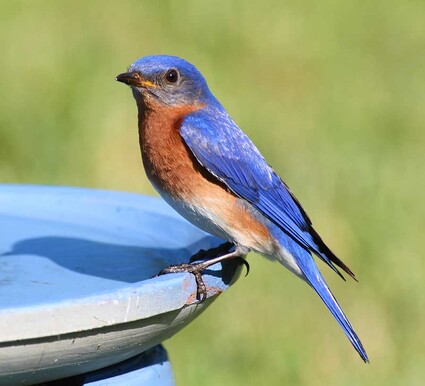Helping our birds in high heat
Last updated 7/26/2022 at Noon
The outside thermometer has launched into the red zone. We know that heat can have concerning health impacts, but not just for us upright two-leggeds. Everyone suffers in extreme heat — insects, mammals, and birds, as well as those with roots holding them in one place, plants.
The animals and plants of Central Oregon are adapted to some heat extremes. But last year, we beat all records when we catapulted up into the triple digits of 115 degrees. And here we are again in the 100s. So, what can we do to help our flighted friends?
Our yard birds do have physiological adaptations that help them survive high heat. Depending on the species, birds’ normal temperatures run between 101-106 degrees. When the thermostat rises and the temps begin to approach their internal temperatures, they risk heat exhaustion, stress, and stroke just like the rest of us.
Because birds don’t sweat, they have adapted different strategies for cooling off. Mainly, they pant. Cooling is done by air passing across the wet tissues in the mouth and throat, called evaporative cooling. They can also flutter the skin at the front of the neck. To release heat from their naturally warm armor of feathers, they have this amazing ability to lift each individual feather due to muscles at the base. Those scaly, bare legs also help jettison heat.
However, panting and exposing the skin to air can lead to dehydration if the lost moisture is not replaced quickly. This is another way high heat kills. Having bird baths, water feathers, or just a simple mister going can be lifesaving for a number of species. Keep those baths clean, though, and with fresh, cool water. Move them to the shade.
A single mist sprayer or a soaker hose set on medium is water conservative, but birds love the spray. Soak the rocky places the frogs hang out. Put out a tray — like a plant tray — for the bunnies and the low grounders and a stock tank or big tub for the deer. If on more land, water down the native shrubs for those who don’t like the commotion of our homes. Finally, soak some open dirt for all those bees and bugs we need to help these days.
If you have birds in boxes, a tent canopy set over it and up away from the box can lower the temp inside. Boxes should always be larger these days, due to heat, and have ventilation.
Birds also need shelter from the heat, like dense shrubs, ground plants, and trees — our native plants are Olympic-scale winners at this. Birds will avoid being out much of the day and restrict their food-seeking, so keep those feeders full. Sunflower hearts with no shell pack a nutritional punch. Millet on the ground for the doves and quail. Whole sunflower and Niger thistle, of course. And then stop with all suet as it will go rancid, and the soft oils contaminate bird feathers, worsening the situation.
We all need a cool-down in these hot times; so do our wild neighbors. Follow these simple tips, and your birds will be ever so thankful.
Elise Wolf is the proprietor of Native Bird Care in Sisters.












Reader Comments(0)